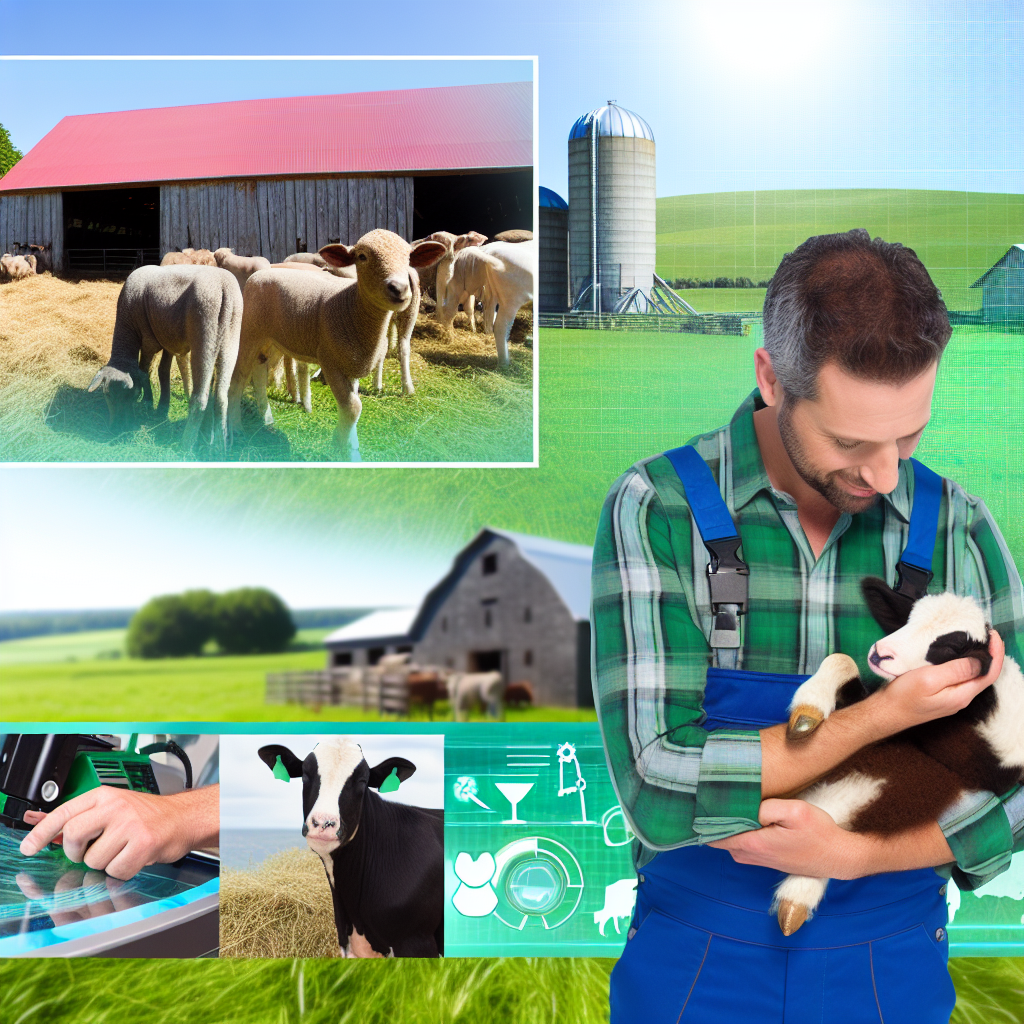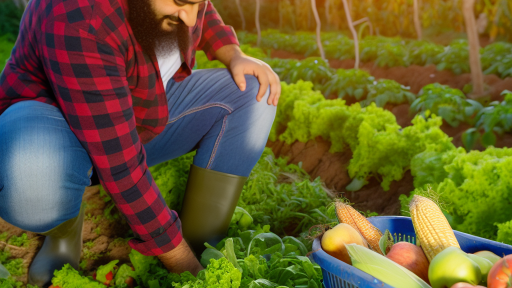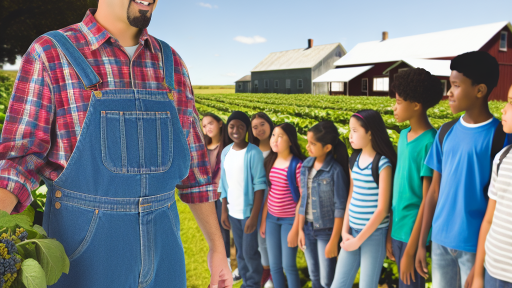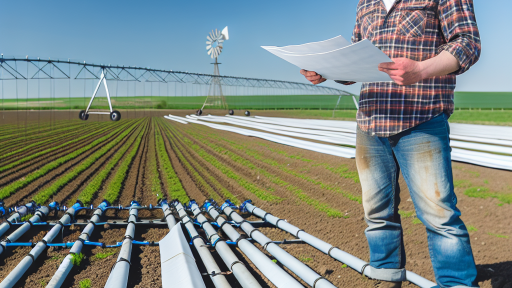Introduction to Sustainable Animal Farming
Defining Sustainable Animal Farming
Sustainable animal farming refers to practices that focus on environmental stewardship.
This approach aims to minimize negative impacts on biodiversity and ecosystems.
Moreover, it emphasizes animal welfare and public health.
Importance of Sustainability in Animal Farming
Sustainable practices are crucial for reducing greenhouse gas emissions.
They help conserve natural resources like water and soil.
Additionally, these methods enhance food security for future generations.
Key Principles of Sustainable Animal Farming
- Animal welfare ensures humane treatment throughout their life cycles.
- Resource efficiency minimizes waste and maximizes output.
- Systems thinking considers the interconnections within farming ecosystems.
Challenges in Implementing Sustainable Practices
Farmers often face economic pressures that favor conventional methods.
Transitioning to sustainable practices requires initial investments.
Additionally, there is sometimes a lack of knowledge about sustainable techniques.
Examples of Sustainable Practices
- Rotational grazing promotes soil health and reduces erosion.
- Integrated pest management minimizes pesticide use.
- Utilizing renewable energy sources decreases reliance on fossil fuels.
The Future of Sustainable Animal Farming
Innovation plays a key role in advancing sustainable practices.
Technological advancements can enhance efficiency and reduce impacts.
Collaboration among farmers, scientists, and policymakers is essential.
Benefits of Sustainable Practices for Animal Welfare
Improved Living Conditions
Sustainable practices provide better living conditions for animals.
Animals enjoy more space and access to natural environments.
These enhanced conditions promote their overall well-being.
Transform Your Agribusiness
Unlock your farm's potential with expert advice tailored to your needs. Get actionable steps that drive real results.
Get StartedConsequently, healthier animals result in better productivity.
Reduction of Stress
Implementing sustainable methods reduces stress among animals.
For instance, less crowded spaces lead to calmer behavior.
Stable environments contribute significantly to animal happiness.
Ultimately, lower stress levels enhance meat and milk quality.
Enhanced Health and Disease Management
Sustainable animal farming practices support better health management.
Farmers can monitor animal health more effectively.
Furthermore, natural diets reduce reliance on antibiotics.
Healthy animals are less prone to diseases.
Ethical Treatment of Animals
Adopting sustainable practices aligns with ethical treatment.
These practices respect animal rights and welfare principles.
Consumers increasingly demand transparency in food production.
Consequently, ethical farming can enhance business reputation.
Economic Benefits
Sustainable practices can lead to significant economic advantages.
Farmers often experience lower operating costs over time.
Investing in sustainable methods attracts conscientious consumers.
In addition, organically raised animals fetch higher market prices.
Use of Regenerative Agriculture Techniques
Introduction to Regenerative Agriculture
Regenerative agriculture goes beyond sustainability.
It focuses on restoring ecosystems while farming.
This method enhances soil health and biodiversity.
Soil Health Restoration
Healthy soil is the backbone of regenerative agriculture.
Farmers utilize cover crops to improve soil structure.
These crops prevent erosion and increase moisture retention.
Furthermore, they fix nitrogen in the soil naturally.
Showcase Your Farming Business
Publish your professional farming services profile on our blog for a one-time fee of $200 and reach a dedicated audience of farmers and agribusiness owners.
Publish Your ProfileDiversity in Crop and Livestock Systems
Diversifying species boosts resilience in farming systems.
Integrating animals into cropping systems provides natural fertilization.
Rotational grazing enhances grassland health and carbon sequestration.
This practice reduces the need for synthetic fertilizers.
Use of Compost and Organic Amendments
Compost enriches soil with nutrients and beneficial microorganisms.
Farmers create compost from farm waste and organic materials.
Applying compost improves soil fertility and structure.
As a result, it increases crop yields sustainably.
Water Management Practices
Efficient water management is essential in regenerative farming.
Farmers implement techniques like rainwater harvesting.
This practice ensures sustainable water use and conservation.
Additionally, creating swales helps in managing water runoff.
Encouraging Biodiversity
Enhancing biodiversity supports pest control and crop pollination.
Farmers plant a variety of native species to attract beneficial insects.
This practice minimizes the need for chemical pesticides.
Moreover, maintaining hedgerows provides habitats for wildlife.
Community Engagement and Knowledge Sharing
Engaging local communities fosters knowledge exchange.
Farmers share best practices and collaborate on regeneration efforts.
By building networks, they create resilience in agriculture.
Education programs promote awareness of regenerative practices.
Delve into the Subject: Leveraging Online Platforms for Direct Farm Sales
Organic Feed and Its Impact on Livestock Health
The Importance of Organic Feed
Organic feed plays a crucial role in livestock farming.
It contributes to the overall health of animals.
Farmers prefer organic feed to ensure animal welfare.
Furthermore, organic feed reduces the risk of disease.
Nutritional Benefits of Organic Feed
Organic feed typically offers superior nutrition.
It contains higher levels of vitamins and minerals.
Consequently, animals grow stronger and healthier.
This leads to better meat and milk production.
Reducing Chemical Exposure
Using organic feed minimizes chemical exposure.
Conventional feed often includes harmful additives.
In contrast, organic standards prohibit synthetic chemicals.
This promotes healthier livestock with fewer health issues.
Environmental Impact of Organic Farming
Organic farming practices benefit the environment significantly.
They enhance soil health through crop rotation and composting.
Additionally, organic feed reduces pollution from fertilizers.
This creates a more sustainable farming model.
Case Studies of Successful Implementation
Several farms have successfully transitioned to organic feed.
Green Meadows Farm reports increased livestock health.
Their organic practices led to a 30% reduction in disease outbreaks.
Showcase Your Farming Business
Publish your professional farming services profile on our blog for a one-time fee of $200 and reach a dedicated audience of farmers and agribusiness owners.
Publish Your ProfileSunny Acres Farm also highlights improved milk quality.
Challenges in Adopting Organic Feed
Transitioning to organic feed poses challenges.
Farmers face higher initial costs for organic products.
Additionally, sourcing reliable organic feed can be difficult.
However, the long-term benefits often outweigh these challenges.
Future of Organic Feed in Animal Farming
The demand for organic products is steadily increasing.
This trend encourages more farmers to adopt organic practices.
As consumer awareness grows, so does market potential.
Ultimately, organic feed will shape the future of sustainable farming.
Discover More: Implementing Organic Techniques In Modern Farming
Animal Breeding for Sustainability: Choices and Considerations
Importance of Sustainable Animal Breeding
Sustainable animal breeding plays a critical role in farming.
It helps enhance the productivity and resilience of livestock.
Moreover, it promotes animal welfare and ecological balance.
Genetic Diversity and Health
Ensuring genetic diversity is essential for sustainable breeding.
It protects against diseases and reduces inbreeding risks.
Farmers can achieve this through selective breeding practices.
Additionally, innovative technologies help improve genetics.
Breed Selection
Choosing the right breeds is vital for sustainability.
Farmers must consider environmental suitability for each breed.
Some breeds are more resilient to climate changes than others.
Furthermore, selecting breeds based on productivity and feed efficiency is crucial.
Lower Resource Input
Effective animal breeding reduces resource input significantly.
For instance, improved feed conversion ratios lower feed costs.
This efficiency maximizes farm profitability and minimizes waste.
Animal Welfare Considerations
Animal welfare should guide breeding choices.
Breeds selected for their welfare traits enhance animal wellbeing.
Furthermore, welfare-friendly practices attract consumer support and trust.
Community and Economic Impacts
Sustainable breeding affects local communities positively.
It supports local economies by providing high-quality livestock.
Moreover, investing in local breeding programs strengthens community ties.
Future Directions in Breeding
The future of animal breeding will leverage technology and data.
Genomic selection techniques will become more widespread.
Additionally, precision agriculture can optimize breeding outcomes.
Ultimately, the goal is to create a sustainable and resilient food system.
See Related Content: Connecting Farmers with Local Consumers Effectively
Water Management Practices in Sustainable Animal Farming
Importance of Water Management
Water management plays a crucial role in sustainable animal farming.
It ensures livestock have consistent access to clean water.
Moreover, effective management conserves water resources.
This practice promotes animal health and welfare.
Additionally, it reduces environmental impacts associated with water use.
Showcase Your Farming Business
Publish your professional farming services profile on our blog for a one-time fee of $200 and reach a dedicated audience of farmers and agribusiness owners.
Publish Your ProfileTechniques for Efficient Water Use
Farmers can adopt various techniques to enhance water efficiency.
Implementing rainwater harvesting can significantly reduce water costs.
This technique captures and stores rainwater for later use.
Moreover, using drought-resistant crops minimizes overall water demand.
These crops require less water, offering sustainable solutions for feed.
Utilizing Innovative Technologies
New technologies provide farmers with tools to manage water wisely.
Automated irrigation systems help deliver precise water amounts.
This technology prevents overwatering and optimizes resource use.
Additionally, water recycling systems can minimize waste.
These systems treat and reuse wastewater for various purposes.
Training and Education
Providing training on water management is vital for success.
Farmers should understand best practices for water conservation.
Workshops and seminars can enhance their knowledge and skills.
Consequently, educated farmers make better decisions regarding water use.
Collaboration with water management experts also proves beneficial.
Monitoring and Assessment
Regular monitoring of water usage is essential.
Farmers should track their water consumption over time.
This practice helps identify areas for improvement.
Furthermore, using technology for real-time monitoring can boost efficiency.
Assessing water quality ensures it meets safety standards for livestock.
See Related Content: Climate Resilience In Sustainable Agricultural Practices

Integration of Crop and Livestock Systems
Holistic Approach
Integrating crops and livestock creates a holistic farming system.
This method optimizes land use through synergistic relationships.
Crops provide feed, while livestock contribute manure for fertilization.
Ultimately, this cycle enriches the soil and enhances productivity.
Improving Resource Efficiency
Combining crop and livestock systems increases resource efficiency.
This integration reduces dependence on synthetic fertilizers.
Farmers utilize natural inputs more effectively.
Thus, they decrease overall production costs and environmental impact.
Enhancing Nutritional Diversity
Integrating livestock and crops promotes nutritional diversity.
Farmers can produce varied food sources on a single piece of land.
This variety supports healthier diets for local communities.
Moreover, it fosters economic resilience against market fluctuations.
Promoting Soil Health
Crop-livestock integration significantly improves soil health.
Manure enriches the soil with essential nutrients.
In addition, diverse crops prevent soil erosion and enhance structure.
Healthy soil leads to more resilient ecosystems and crop yields.
Case Studies of Successful Integration
Farms like Green Valley Ranch illustrate successful integration.
They cultivate crops alongside raising dairy cattle.
This practice boosts yields and creates a sustainable cycle.
Showcase Your Farming Business
Publish your professional farming services profile on our blog for a one-time fee of $200 and reach a dedicated audience of farmers and agribusiness owners.
Publish Your ProfileFurthermore, it allows them to market both produce and dairy products effectively.
Technological Innovations Supporting Sustainable Practices
Precision Agriculture
Precision agriculture utilizes technology to increase efficiency in farming.
This approach helps farmers make informed decisions based on data.
For instance, GPS technology allows for precise planting and harvesting.
Farmers can minimize resource use by applying inputs more accurately.
Consequently, this reduces waste and environmental impact.
Biotechnology in Animal Feed
Biotechnology offers innovative solutions for animal feed production.
Engineered feed additives improve nutrition and health in livestock.
This leads to better growth rates and lower mortality.
Additionally, some feed components reduce methane emissions in ruminants.
As a result, biotechnology contributes to cleaner animal farming.
Smart Sensor Systems
Smart sensor systems monitor animal health and environmental conditions.
These systems can detect illness early through behavioral analysis.
Moreover, they can track temperature, humidity, and other factors.
By optimizing conditions, farmers enhance animal welfare and productivity.
This technology reduces the reliance on antibiotics and other treatments.
Renewable Energy Sources
Implementing renewable energy sources is another sustainable practice.
Solar panels and wind turbines can power farms efficiently.
This reduces dependency on fossil fuels and lowers carbon footprints.
Additionally, anaerobic digesters can convert waste into energy.
Farmers can generate their energy while managing waste effectively.
Blockchain Technology
Blockchain technology enhances transparency in food supply chains.
This innovation records every step of production and distribution.
Consumers can trace the origin of their food products easily.
In turn, this builds trust and encourages sustainable sourcing practices.
Furthermore, it helps farmers document their sustainability efforts accurately.
Case Studies: Successful Sustainable Animal Farming Models
Grass-Fed Beef Operations
Grass-fed beef operations exemplify sustainable cattle farming.
These farms utilize rotational grazing methods.
This approach improves soil health and fosters biodiversity.
Additionally, it reduces greenhouse gas emissions.
For instance, Sunny Meadows Farm in Texas showcases this model.
The farm has increased its herd size while improving pasture quality.
Poultry Farming Innovations
Poultry farming innovations demonstrate sustainability in avian agriculture.
One successful model employs mobile coops for raising chickens.
This system provides fresh pasture to the birds daily.
Consequently, it benefits both the flock and the land.
For example, Free Range Farm in Virginia has adopted this technique.
The farm reports healthier birds and higher egg production rates.
Integrated Crop-Livestock Systems
Integrated crop-livestock systems enhance sustainability in farming.
These systems combine animal and crop production strategically.
Showcase Your Farming Business
Publish your professional farming services profile on our blog for a one-time fee of $200 and reach a dedicated audience of farmers and agribusiness owners.
Publish Your ProfileThis synergy maximizes resource efficiency and minimizes waste.
A notable example is the Black Creek Farm in Wisconsin.
The farm utilizes manure from its cattle to fertilize crops.
This practice reduces chemical fertilizer needs and enhances soil quality.
Community-Supported Agriculture
Community-supported agriculture (CSA) empowers local farming efforts.
These initiatives connect farms directly with consumers.
CSAs often include sustainable animal products in their offerings.
For example, Happy Valley CSA in Oregon features local eggs and meat.
This model fosters a sense of community while promoting sustainability.
Aquaponics in Animal Farming
Aquaponics integrates fish farming and plant cultivation sustainably.
This system recycles nutrients between fish and plants.
For instance, FreshWater Farms in Ohio demonstrates this innovative approach.
The farm raises tilapia while growing organic vegetables simultaneously.
This method conserves water and creates nutrient-rich food sources.
Future Trends in Sustainable Animal Farming Approaches
Introduction to Emerging Practices
Emerging practices in sustainable animal farming focus on efficiency and environmental stewardship.
Farmers increasingly adopt innovative techniques to enhance animal welfare and reduce waste.
Integration of Technology
Technology significantly transforms how farmers manage livestock.
For instance, precision farming uses data analytics for optimal resource allocation.
This approach minimizes feed waste and maximizes production efficiency.
Automation and Robotics
Automation and robotics streamline daily farm operations.
Automated feeding systems ensure animals receive the right nutrients on time.
Moreover, robotics assist in monitoring animal health, reducing human labor needs.
Use of Genetic Innovations
Genetic innovations help develop breeds better suited for sustainable farming.
These breeds often require fewer resources and resist diseases more effectively.
Farmers can decrease their reliance on antibiotics through healthier genetic stock.
Practices to Reduce Carbon Footprint
Farmers are increasingly aware of their carbon footprints.
They implement practices that reduce greenhouse gas emissions.
Rotational Grazing
Rotational grazing promotes healthier pastureland and reduces erosion.
This method increases soil health and improves carbon sequestration capabilities.
Utilizing Alternative Feeds
Exploring alternative feeds can lead to lower emissions in livestock farming.
For example, insects and seaweed enhance nutrient intake and decrease methane production.
Consumer Awareness and Demand
Consumers are driving the demand for sustainable products.
They seek transparency about farming practices and animal welfare standards.
Labeling and Certification
Certification programs help consumers identify sustainable products easily.
Labels such as “organic” or “grass-fed” influence consumer purchasing decisions.
Community Supported Agriculture
Community-supported agriculture (CSA) connects local farms and consumers directly.
This model supports local economies and reinforces sustainable practices.
Regulatory Changes and Incentives
Governments play a crucial role in promoting sustainable animal farming.
Accordingly, they introduce regulations and incentives for eco-friendly practices.
Subsidies for Sustainability
Subsidies encourage farmers to transition to sustainable methods.
Showcase Your Farming Business
Publish your professional farming services profile on our blog for a one-time fee of $200 and reach a dedicated audience of farmers and agribusiness owners.
Publish Your ProfileSuch financial support can cover costs for new technologies or methods.
Research and Development Investments
Investing in research boosts innovation in sustainable farming practices.
Collaboration between universities and farms brings new findings to light.




